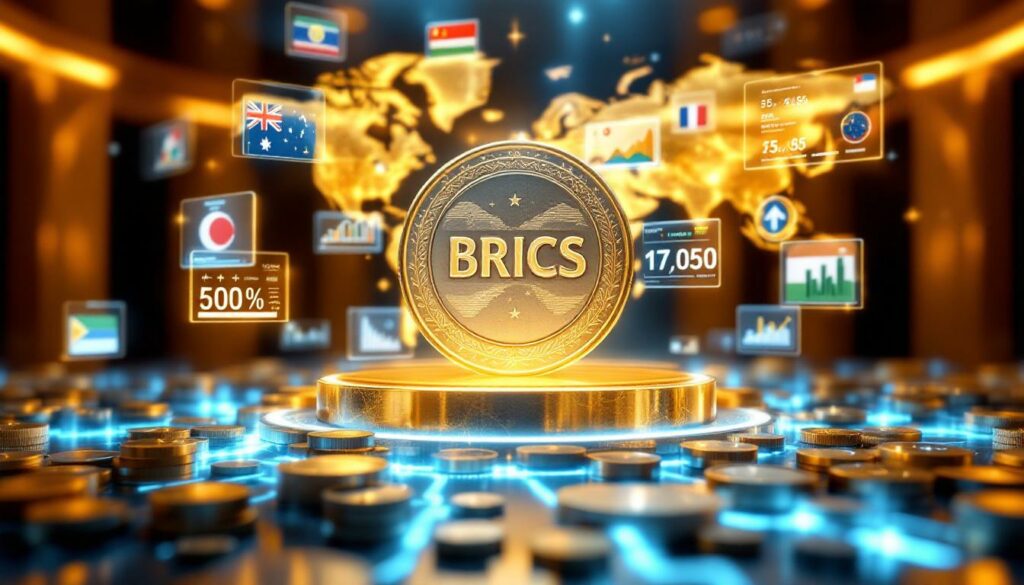What is the BRICS Alliance and Why Does It Matter?
The BRICS alliance has emerged as a significant counterbalance to Western-dominated global financial institutions. Originally comprising Brazil, Russia, India, China, and South Africa, this coalition now represents a substantial portion of the world's population, natural resources, and economic output. What makes BRICS particularly noteworthy is its distinct operational framework that differs fundamentally from Western alliances.
Unlike traditional Western coalitions that demand uniform policy alignment, BRICS embraces a more flexible approach to cooperation. As London Paul of the Sirius Report explains, "it's not really an alliance as the West perceives an alliance to be. This is why you can have countries like India who disagree with something and that's not a problem. No one has a problem with any country disagreeing. Not every country has to sign up to all the initiatives."
The Evolution of BRICS Membership
The original five members have now been joined by new nations eager to participate in this alternative economic framework. The 2024 expansion brought Egypt, Ethiopia, Iran, Saudi Arabia, and the United Arab Emirates into the fold, significantly increasing the alliance's geographic and economic footprint.
Beyond full membership, numerous countries from the Global South have been granted observer status, allowing them to participate in discussions and potentially join initiatives without full membership commitments. According to London Paul, approximately "20 or 30 countries would like to join" BRICS, demonstrating the growing appeal of this alternative economic alliance.
Looking ahead, India will assume the BRICS presidency in 2026, with London Paul noting that "they've already shared the kind of things they'd like to push with regards to BRICS with the Russians and the Chinese are very happy with these developments." This indicates continued evolution and expansion of the alliance's scope and influence.
How Are BRICS Nations Challenging Dollar Dominance?
The BRICS currency and multipolarity framework has implemented several concrete strategies to reduce dependence on the US dollar, creating alternative financial mechanisms that bypass Western-controlled systems. These efforts have accelerated in recent years, particularly following sanctions against Russia that highlighted the vulnerabilities of dollar dependence.
Local Currency Settlement Mechanisms
Perhaps the most significant development has been the rapid shift toward local currency settlements between BRICS nations. London Paul observes that "China and Russia trade almost 100% in the ruble and the yuan," completely bypassing the dollar in their bilateral trade. This trend extends beyond just these two countries, with Paul noting that "by the end of 2024, probably about 45% of China's trade with other currencies was settled in yuan—that's more than double what it was at the end of 2022."
This shift represents a deliberate strategy to insulate member economies from potential sanctions and reduce exposure to commodities market volatility. By establishing direct currency exchange mechanisms, BRICS nations can conduct trade without the need for dollars as an intermediary currency.
China's CIPS: A SWIFT Alternative Growing in Significance
China's Cross-Border Interbank Payment System (CIPS) has emerged as a viable alternative to the Western-dominated SWIFT system. Andrew Maguire highlights the dramatic growth of this alternative: "In 2024 in cross-border transactions, they [CIPS] processed 175 billion yuan, which is more or less 24.5 trillion [USD] equivalent. That was up 43% from 2023."
The system's reach continues to expand rapidly, with Maguire noting that "CIPS already interconnects with what like 4,900 banking institutions" across more than 150 countries. This growing network provides the infrastructure necessary for conducting international trade without relying on Western financial messaging systems that could be leveraged as geopolitical tools.
| CIPS Metrics | 2023 | 2024 | Growth Rate |
|---|---|---|---|
| Connected Banking Institutions | ~3,000 | ~4,900 | 63% |
| Transaction Volume (Yuan) | 122 billion | 175 billion | 43% |
| USD Equivalent | ~$17 trillion | ~$24.5 trillion | 43% |
| Global Reach | 100+ countries | 150+ countries | 50% |
This rapid expansion demonstrates the growing appetite for alternative settlement systems outside Western control, particularly following Western sanctions against Russia that highlighted the risks of dollar dependence.
What Are the Strategic Advantages of the BRICS Alliance?
The BRICS coalition possesses several strategic advantages that make it a formidable economic bloc on the global stage, with resource dominance and growing financial independence being particularly significant.
Resource Dominance and Commodity Control
BRICS nations collectively control an impressive array of natural resources that are essential to the global economy. Russia stands as the world's second-largest gold producer after China, giving the alliance significant influence over precious metals markets. Additionally, the expanded BRICS membership now includes major oil producers like Saudi Arabia, Iran, and the UAE, dramatically increasing the bloc's energy market footprint.
The alliance's control extends across energy resources, precious metals, agricultural commodities, industrial metals, and critical minerals strategy—effectively giving BRICS nations leverage in establishing alternative pricing mechanisms outside dollar-denominated systems.
London Paul observes that "China took the opportunity to hoover everything they could get their hands on," referring to China's strategic stockpiling of commodities. This accumulation of physical resources provides a tangible foundation for financial initiatives that might otherwise be vulnerable to market manipulation or sanctions.
Growing Financial Independence
BRICS nations have systematically developed institutions that parallel and potentially rival Western-dominated financial frameworks. The New Development Bank provides infrastructure financing that bypasses World Bank conditions, while investment funds offer loan guarantees outside IMF frameworks.
This infrastructure extends beyond just lending. BRICS central banks have been systematically increasing their gold reserves, with Russia incorporating silver into its strategic reserves as well. As London Paul notes, more investors are "taking money out of places like the United States" and redirecting capital toward BRICS economies and financial instruments.
These developments collectively create an ecosystem where BRICS nations can operate with increasing independence from traditional Western financial institutions and the constraints they might impose.
Is a BRICS Currency Actually Coming?
Despite widespread speculation about a unified BRICS currency, the alliance is taking a measured, pragmatic approach to monetary cooperation rather than rushing toward a single currency model.
Current Focus: Local Currency Settlements
The immediate priority for BRICS nations is strengthening bilateral and multilateral trade in local currencies. London Paul clarifies that "the focus is on trading in local currencies between the countries" rather than developing a unified currency. This approach allows for increased de-dollarization without the complications of monetary union.
This strategy reflects lessons learned from the Eurozone's challenges. As London Paul explains, "The Euro currency was doomed to fail because you're trying to marry desperate economies, say between Germany in the north and Greece, Portugal, etc. in the south. It was destined never to succeed. They don't want to make the same mistake."
By focusing on practical mechanisms for settlement rather than currency unification, BRICS currency and multipolarity initiatives can achieve many of the benefits of monetary cooperation while avoiding the pitfalls that have plagued other currency unions.
Potential Future Developments
While a unified currency isn't imminent, several developments point toward increased monetary cooperation. London Paul emphasizes the importance of infrastructure, noting that "you have to start to put the building blocks in place… until you get those building blocks in place, there's no point really worrying too much about what a BRICS currency could be."
These building blocks include digital settlement platforms, commodity-based pricing mechanisms, and standardized regulatory frameworks that facilitate smoother cross-border transactions. Rather than focusing on a singular currency, BRICS appears to be developing a network of interoperable systems that collectively reduce dollar dependence without requiring the political integration a unified currency would demand.
How Is Gold Central to BRICS Financial Strategy?
Gold plays a pivotal role in BRICS nations' strategy to create alternatives to the dollar-based financial system, serving as both a strategic reserve asset and a foundation for new financial mechanisms.
Gold Accumulation and Reserve Building
BRICS central banks have been systematically increasing their gold reserves, with Andrew Maguire noting that "Russia is actually the second largest gold producer in the world after China." This production capacity gives these nations significant advantages in building gold reserves without relying on international markets.
Beyond just accumulation, there are indications that gold is being integrated into the broader financial architecture of BRICS nations. According to London Paul, "China effectively did announce the gold backing of its currency because it's said in international trade that the yuan is fully convertible into gold." This convertibility provides a level of confidence in the yuan that fiat currencies typically lack.
The strategic importance of precious metals extends beyond just gold, with London Paul revealing that "Russia very quietly slipped in silver into their basket of strategic reserves," indicating a comprehensive approach to monetary metals.
New Gold Trading Mechanisms
BRICS nations are developing alternative gold trading and pricing mechanisms outside traditional Western systems. Andrew Maguire explains that Russia's St. Petersburg International Mercantile Exchange "wants to reduce its reliance on the LMA" and establish "domestic price benchmarks" for precious metals.
These efforts to create independent price discovery mechanisms could eventually challenge the dominance of London and New York in setting global gold prices analysis. When combined with physical backing requirements and deliverability guarantees, these new trading venues potentially offer greater transparency and connection to physical metal than their Western counterparts.
The Shanghai Gold Exchange already requires physical backing for contracts, and new gold vaults are being established throughout BRICS nations to facilitate physical settlement of trades. This emphasis on physical metal rather than paper contracts represents a significant departure from Western practices and potentially addresses long-standing concerns about price manipulation in precious metals markets.
What Role Does Silver Play in the Multipolar Financial System?
While gold receives more attention in discussions of monetary metals, silver is increasingly important in BRICS nations' strategic planning, serving both industrial and monetary functions.
Industrial and Monetary Significance
Silver's dual role as both an industrial metal and monetary asset makes it particularly valuable in the emerging multipolar system. London Paul emphasizes that "the case for silver is self-explanatory given it's also an industrial metal and the demand for silver is only going to increase due to all the technological advancements that we now see in the world."
This industrial demand provides a floor for silver prices that purely monetary metals lack. As renewable energy, electronics, and medical applications continue to expand, physical silver demand increases accordingly. This dynamic is already being recognized at the strategic level, with London Paul revealing that "Russia very quietly slipped in silver into their basket of strategic reserves."
The inclusion of silver in national reserves represents a significant shift in perspective, acknowledging both its monetary history and its strategic importance in modern industry. This dual functionality makes silver particularly valuable in a resource-based financial system.
Market Dynamics Revealing Physical Constraints
Recent market behavior indicates growing stress in silver markets, with physical demand outpacing available supply. Andrew Maguire provides specific examples: "on the 11th of July… we recorded… a 92 cent COMEX premium, $4,600 per contract" and notes that "today it's still 40 cents and we've got silver approaching $40 bucks."
These persistent premiums reflect the difficulty of sourcing physical silver despite relatively high prices, with London Paul asserting that "there are global shortages of physical silver that's irrefutable even from very basic international data."
The silver market squeeze has become increasingly obvious, with exchange for physical (EFP) spreads reaching unprecedented levels. This divergence suggests that paper market prices may not accurately reflect the true value of physical silver, creating both risks and opportunities as the multipolar system evolves.
How Are Western Financial Markets Responding to These Changes?
Western financial institutions and governments are showing signs of stress as BRICS alternatives gain traction, with both investors and central banks increasingly seeking alternatives to traditional dollar-denominated assets.
Diminishing Trust in Traditional Systems
There are growing indications that confidence in Western financial systems is eroding. London Paul observes that "investors have been taking money out of the US, selling dollar-denominated assets and buying Chinese bonds. They've even ironically been going into Europe buying European bonds like the German bonds."
This capital flight extends beyond just private investors. Andrew Maguire notes that the "World Gold Council came out and did a survey of, I think, 36 central banks… [who] said yeah, we're buying gold directly from artisanal [miners]… we're not going through London anymore." This bypassing of traditional financial centers represents a significant shift in central bank behavior.
These changes reflect growing concerns about Western financial system stability, dollar depreciation risks, and potential sanctions vulnerability. By diversifying away from dollar-denominated assets and Western financial centers, both investors and institutions are hedging against these perceived risks.
Attempts to Maintain Relevance
Western institutions are attempting to adapt to the changing landscape, primarily through digital currency initiatives, regulatory adjustments, and various forms of market intervention. However, these efforts often appear reactive rather than strategic, focused more on maintaining the status quo than adapting to the emerging multipolar reality.
The disconnect between paper markets and physical markets continues to widen, creating arbitrage opportunities that savvy investors can exploit. As physical commodities become increasingly important in the new financial architecture, Western paper markets may struggle to maintain their price discovery function without significant reforms.
What Was Decided at the 2024 BRICS Rio Summit?
The 2024 BRICS summit in Rio de Janeiro marked significant progress in several key areas, though Western media provided minimal coverage of these developments. The summit focused on practical initiatives rather than ideological statements, building infrastructure for longer-term strategic goals.
Major Initiatives Announced
One of the most significant developments involved what Andrew Maguire describes as "the tokenization and the financialization of real world assets between the BRICS nations." This initiative potentially creates a framework for asset-backed digital transactions that could operate independently of Western financial systems.
Additionally, London Paul highlights that "this development with the New Development Bank in terms of trying to massively fund investment, you know, infrastructure projects etc. with these loan guarantees is a huge step forward." The expansion of the New Development Bank's role provides BRICS nations with greater independence from Western-dominated institutions like the World Bank and IMF.
The summit also advanced cross-border payment mechanisms that operate outside of SWIFT, further reducing BRICS nations' vulnerability to Western financial sanctions. These practical steps toward financial independence received little Western media attention but represent significant progress toward a more multipolar financial system.
Strategic Restraint in Messaging
BRICS leaders deliberately maintained low-key messaging about certain initiatives, focusing on implementation rather than proclamations. This approach allows projects to advance without generating unnecessary resistance or triggering reactive measures from Western powers.
By emphasizing practical cooperation rather than ideological statements, BRICS nations can build alternative systems while minimizing geopolitical tensions. This gradualist approach prioritizes tangible results over symbolic victories, creating sustainable alternatives rather than direct confrontations.
What Does Multipolarity Mean for Global Finance?
The rise of BRICS currency and multipolarity represents a fundamental shift in global financial architecture with far-reaching implications for currencies, commodities, and financial institutions worldwide.
End of Dollar Hegemony
The emerging multipolar system challenges the dollar's position as the world's dominant reserve currency. London Paul asserts that "the writings on the wall for fiat based currencies. The what I would call USy, the US empire or the western empire, the dollar-based empire is rapidly coming to an end."
This transition involves multiple reserve currencies rather than dollar dominance, with regional financial centers challenging New York and London's traditional roles. Asset-backed settlement mechanisms are replacing purely fiat-based systems, prioritizing physical commodities over paper promises.
The shift toward commodity pricing outside dollar denomination represents a particularly significant change. As energy, metals, and agricultural products begin trading in alternative currencies or direct bilateral exchanges, the dollar's role as intermediary currency diminishes accordingly.
New Principles of International Finance
The BRICS approach to international finance emphasizes different principles than the Western model, focusing on non-interference in domestic affairs and respect for sovereignty in financial relationships. This approach allows for greater diversity in economic models and development strategies, contrasting with the standardized policies often imposed by Western institutions.
The emphasis on win-win cooperation rather than zero-sum competition potentially creates more balanced trade relationships, while the focus on development rather than financialization prioritizes real economic growth over speculative profits. This reorientation toward the physical economy represents a significant departure from Western financial practices of recent decades.
How Might Western Nations Adapt to Multipolarity?
Western nations face critical choices in how to respond to the emerging multipolar reality, with successful adaptation requiring significant policy shifts and institutional reforms.
Potential Adaptation Strategies
The most constructive approach would involve cooperative engagement with BRICS initiatives, acknowledging the changing global landscape rather than resisting it. This could include participation in alternative settlement systems, resource-backed financial instruments, and development-focused investment projects.
Domestic financial reforms addressing systemic weaknesses would be essential for Western economies to remain competitive in a multipolar world. Reducing the weaponization of financial systems would help rebuild trust with nations that have experienced sanctions or monetary restrictions.
A renewed focus on productive economic activity rather than financialization could strengthen Western economies' foundations, while diplomatic reorientation toward mutual respect might facilitate more constructive international relationships. These adaptations would require significant shifts in both policy and perspective but could ultimately lead to more sustainable economic models.
Challenges to Western Adaptation
Several factors complicate Western adaptation to multipolarity, including ideological resistance to acknowledging changing power dynamics and entrenched financial interests benefiting from the current system. Political polarization hinders coherent policy responses, while institutional inertia in international organizations slows necessary reforms.
Media narratives that minimize the significance of these changes further complicate adaptation efforts, creating public perceptions that lag behind financial realities. Without accurate information
Ready to Discover the Next Major Mining Opportunity?
Don't miss out on real-time alerts for significant ASX mineral discoveries through Discovery Alert's proprietary Discovery IQ model, transforming complex data into actionable investment insights. Visit the Discovery Alert discoveries page to understand why historic mineral discoveries can generate substantial returns and begin your 30-day free trial today.




